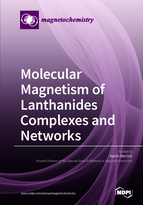Molecular Magnetism of Lanthanides Complexes and Networks
A special issue of Magnetochemistry (ISSN 2312-7481). This special issue belongs to the section "Magnetic Materials".
Deadline for manuscript submissions: closed (15 June 2017) | Viewed by 47031
Special Issue Editor
Interests: lanthanides; coordination chemistry; molecular magnetism; luminescence; single-molecule magnets; single-chain magnets; radical ligands; metal-organic frameworks; multifunctional materials; surfaces
Special Issue Information
Dear Colleagues,
In the last ten years, a fresh air has been blowing in the field of Molecular Magnetism with the re-introduction of lanthanides ions as spin carriers in magnetic molecules. Their strong magnetic moment and huge magnetic anisotropy are strong assets that have enabled breakthroughs in magnetic blocking temperature and related phenomena. The chemical versatility of these ions is also a crucial benefit, as easy substitution among the lanthanides series can either afford isotropic, anisotropic or solid-solutions of magnetic molecules. In a similar way, their well-known luminescent properties have been identified as key features to rationalize SMMs behavior and theoretical approaches have made a great deal of progress.
Moreover, aside from their use as building blocks for high performance SMMs, lanthanides ions permitted the design of unique magnetic compounds that found numerous other applications that ranges from molecular magnetic coolers to spintronics devices, qubits and more generally multifunctional materials.
This Special Issue of Magnetochemistry is a key forum to publish your latest research in lanthanide-based compounds, and, more specifically, in the fields listed below.
Dr. Kevin Bernot
Guest Editor
Manuscript Submission Information
Manuscripts should be submitted online at www.mdpi.com by registering and logging in to this website. Once you are registered, click here to go to the submission form. Manuscripts can be submitted until the deadline. All submissions that pass pre-check are peer-reviewed. Accepted papers will be published continuously in the journal (as soon as accepted) and will be listed together on the special issue website. Research articles, review articles as well as short communications are invited. For planned papers, a title and short abstract (about 100 words) can be sent to the Editorial Office for announcement on this website.
Submitted manuscripts should not have been published previously, nor be under consideration for publication elsewhere (except conference proceedings papers). All manuscripts are thoroughly refereed through a single-blind peer-review process. A guide for authors and other relevant information for submission of manuscripts is available on the Instructions for Authors page. Magnetochemistry is an international peer-reviewed open access monthly journal published by MDPI.
Please visit the Instructions for Authors page before submitting a manuscript. The Article Processing Charge (APC) for publication in this open access journal is 2700 CHF (Swiss Francs). Submitted papers should be well formatted and use good English. Authors may use MDPI's English editing service prior to publication or during author revisions.
Keywords
- Lanthanide-based magnetic molecules (SMMs, SCMs, extended networks and MOFs, organometallics, polyoxometalates, hetero-spin systems,...)
- Lanthanide-based spintronics and qubits
- Lanthanide-based magnetic coolers
- Lanthanide-based magnetic molecules on surfaces
- Lanthanide-based multifunctional magnetic materials
- Computational approaches of Lanthanide-based molecules
- Characterization techniques of Lanthanide-based magnetic materials






